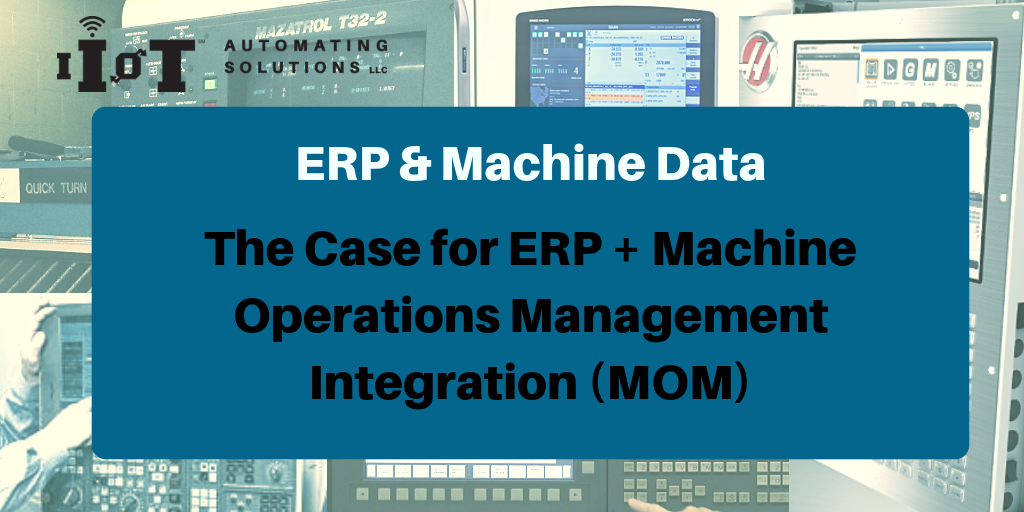
Manufacturers need a well-defined data-management strategy to capitalize on the promises of Industry 4.0. They need to collect increasingly comprehensive information; do it efficiently and ensure that the data is routinely analyzed and acted upon.
In this article, I’ll address the relationship between Enterprise Resource Planning (ERP) and a Machine Operations Management (MOM) as part of a manufacturer’s digital transformation strategy.
It takes a comprehensive Enterprise Resource Planning (ERP) system to plan and manage the sales and production process while providing virtually real-time financial information. Good ERP’s build in many checks and balances to ensure data integrity, but all data is entered by people, which inherently is less accurate that automated data. All machines can provide data, but you need a MOM solution to use it.
A Machine Operations Management (MOM) system provides insights missed by ERP alone. A MOM system uses real-time data to address utilization, availability, quality, performance, operator productivity and downtime reasons. In effect, MOM is focused on the production floor – it measures all the factors that go into Overall Equipment Effectiveness (OEE). In turn, it drives lean and corrective actions and root-cause analysis with actionable data from shop floor to top floor. Manufacturers who use real-time data and makes OEE a key metric maximize their productivity and make high-impact continuous improvements.
When you integrate ERP with MOM, you gain the accuracy of automation and the insights of data from both systems for full context decision making.
Four Approaches for the Use of MOM with ERP Systems
1. MOM within ERP
Some ERP systems have a MOM component. They collect the machine data (indirectly), provide detailed reporting capabilities and can focus an organization on OEE. The downside is they depend on the data entered by people and many require extensive customizations. An operator must clock into a machine, a work order, and report part counts. ERP only sees what people enter.
2. MOM Separate from ERP
A MOM system that collects machine data in real-time removes human error. Actual downtime data reveals the “hidden factory.” Operators supplement information the machine can’t provide. Automated triggers and alerts keep everyone informed. Successful adoption of a real-time MOM system typically drives 10-50% in productivity improvements over ERP MOM or no MOM system.
3. MOM Integrated with ERP – Data from ERP to MOM Solution Only
Jobs from the ERP have key information that can be entered manually at the Machine Operator Portal (MOP) or pushed from a scheduled job in the ERP. Instead of another manual entry, it’s most effective automate. With this data, manufacturers can answer questions like “How did that employee perform on that part on a different day?”
4. MOM Integrated with ERP – Bidirectional Data Transfer – MOM/ERP
The most powerful system puts real-time machine data both in the MOM system and the ERP. The MOM system needs job information for dashboards and reports, and the ERP system needs machine run-times (labor tickets) and part counts for costing & other calculations. The ERP can then use downtime reasons and automatically adjust schedules based on real-time information. Users can see information in whichever system is most comfortable to them. For example, the MOM system can be embedded in the ERP, which keeps most users in the ERP. Only the most advanced configuration and reporting would be done in the MOM solution.
A Machine Operations Management (MOM) system with real-time data collection from machines fully integrated with your ERP has proven benefits:
- Improved adoption of technology, use of machine data
- Reduce the training curve, in a familiar environment
- Accurate part counts, both good and scrap
- Improved costing data
- Improved scheduling and planning
- Real-time "machine down" notifications within ERP & MOM
- Web-portal on cell phones make it easy and economical to report downtime reasons and visualize data
In summary, when you are planning a strategy to use both your ERP and machine data, count on working with a solid, comprehensive solution for both Enterprise Resource Management (ERP) and Machine Operations Management (MOM). Find a partner that knows both systems well and has done this kind of integration before.
Put ERP and MOM together and reap the benefits
of improved productivity that goes right to your bottom line.
